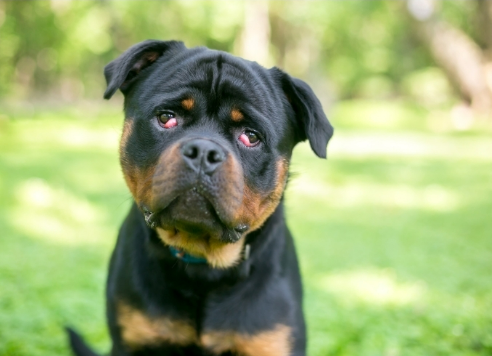
Cherry Eye in Dogs
What on earth is “cherry eye”? Surely it doesn’t refer to a literal cherry as an eye? Actually, “cherry eye” is a common medical condition in dogs. Learn more about what cherry eye is, the causes and risk factors for cherry eye in dogs, clinical signs, potential consequences if left untreated, and management.
What is cherry eye?
Before we explain the abnormal, let’s explain the normal. Unlike humans, dogs (and cats) have third eyelids (a membrane that’s hidden within the inner corner of the eye). The function of the third eyelid is to protect the eye from irritants, and to lubricate the surface by spreading tear film.
Normal third eyelids will not be visible, or will appear as a thin membrane. “Cherry eye” occurs when the third eyelid swells up and is displaced from its original position.
Potential causes and risk factors for cherry eye
The causes and risk factors are not entirely understood yet, and research is being done to understand them. In the meantime, here’s what we do know. Cherry eye tends to occur more often in puppies (under one years old) than in adult dogs. Furthermore, certain breeds are prone. For instance, brachycephalic (flat-faced) breeds such as pugs, bull-dogs and Shih Tzus are more prone to cherry eye. Dogs with cherry eye are also more likely to pass the condition down to their offspring.
Injury and prolonged eye irritation can also predispose for cherry eye. Injury can loosen the ligaments that hold the third eyelid in place, and inflame the third eyelid. Prolonged scratching of the third eyelid (due to conditions such as eye infection) can also displace and inflame the third eyelid.
Clinical Signs of Cherry Eye
Clinical signs of cherry eye include (but are not limited to):
A red lump in the inner corner of the eye. This lump may disappear and reappear
Discharge from eye
Scratching at eye
Redness in eye
-Inability to close eye (in severe cases)
If you notice any of these clinical signs, please consult a veterinarian right away. Some conditions (e.g. eye tumour) can mimic cherry eye, and the management/treatment plan for each condition is very different. This is why a veterinary consultation is needed.
What happens if the cherry eye is left untreated?
You may wonder if “cherry eye" is a harmless condition that can be left alone, especially since the cherry eye can pop in and out sometimes. Short answer? Cherry eye has to be managed. If not, untreated cherry eye can lead to problems such as eye infections and dry eye. In severe cases, dry eye can lead to blindness.
Treatment and Management of Dry Eye
Treatment involves surgery to place the third eyelid back into its original position. More than one corrective surgery may be required, depending on how well the third eyelid responds to the first surgery. Anti-inflammatory prescription eye drops (such as Acular Eye 0.5% Ketorolac Eye Drops 5mL or Ketorom Sterile Eye Drops 5mL ) are often prescribed to reduce the swelling. In some cases, oral non-steroidal anti-inflammatories (like Rimadyl or Meloxicam) may be prescribed. If an infection is present, antibacterial eye drops such as Ciloxan eye drops or Gentamicin eye drops will be prescribed. In some cases, artificial tears are prescribed to help lubricate the eye’s surface.
After eye surgery, it’s important to keep your dog from scratching their face. If you’re worried about plastic cones being uncomfortable, you could try a Comfy cone that will help you to recover in comfort.
If secondary dry eye has already developed, the veterinarian may prescribe tear-stimulating ointments/drops such as Cyclosporine eye ointment. Some vets may prescribe tacrolimus eye ointment, which helps to stabilise the tear film over the eye.
We hope that this article has given you more information about “cherry eye” in dogs. Consult the vet if you have further questions!


Leave a comment